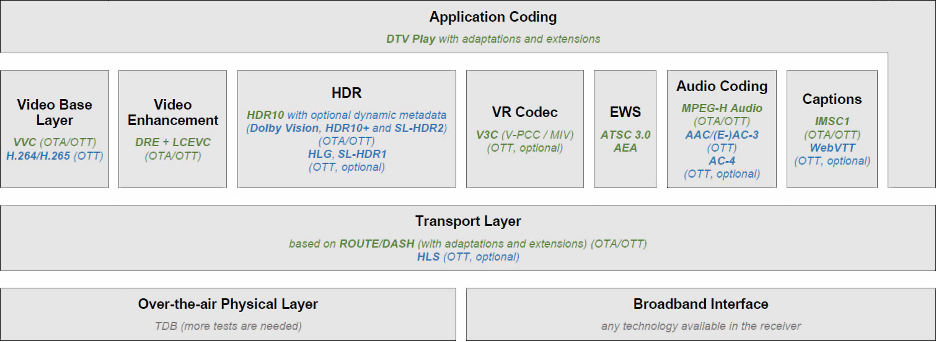After a lengthy and challenging Call for Proposals (CFP) for a next-generation digital TV system called “TV 3.0”, the Brazilian Terrestrial Television System Forum (SBTVD) recently finalized the technical evaluation phase. The SBTVD Forum has thoroughly tested and evaluated different technologies for distributing current and future formats up to 8K resolution to broadcast and OTT networks. Their TV 3.0 official project page lists the selected technologies.
The deployment of Brazil’s TV 3.0 system is planned for 2024, with phase 3 testing in 2022 and 2023.
The ATSC 3.0 and DVB specifications were published a few years ago. From an Ultra HD perspective, it is interesting to see what a 2022 specification looks like, given a 2024 target deployment.
A summary of the different technologies selected is summarized in Figure 1.
| Parameter | Ultra HD Forum Guidelines | SBTVD TV 3.0 specification |
| Resolution | 2160p120 max | up to 8K |
| Color space | BT.2020 | BT.2020 |
| HDR | HDR10* + optional Dynamic metadata (DV, SL–HDR2) HLG SL-HDR1 | HDR10 + optional Dynamic metadata (DV, SL–HDR2, HDR10+) OTT optional: SL-HDR1, HLG |
| Video codec | HEVC | VVC OTT: VVC as main video codec and AVC/HEVC for alternative content |
| Video enhancement | OTT: CAE | DRE + LCEVC |
| Audio | MPEG-H Audio AAC, E-AC-3, Atmos, AC-4 | MPEG-H Audio OTT: AAC/(E-)AC-3, OTT optional: AC-4 |
| Captions | IMSC1 and legacy schemesCTA 608/708, ETSI 300 y43, ESTI 300 w7z, SCTE 27, IMSC1 | IMSC1 OTT: optional WebVTT |
| Transport | OTA: MPEG-2 TS, MMT, ROUTE/DASH OTT: DASH or HLS | OTA/OTT: ROUTE/DASH OTT: optional HLS |
| VR | OTT only: optional MPEG V3C (V-PCC and MIV) |

We compare the different technologies selected vs. what currently exists in the Ultra HD Forum Guidelines and analyze the differences.
HDR10 is PQ10 + static metadata
Here is a brief analysis we can make out of this specification:
- There is no big surprise on the HDR side, with the decision to stick to HDR10 for the OTA workflow with different dynamic metadata variants (DV, HDR10+, SL-HDR2), with HLG and SL-HDR1 being optional for OTT. These choices are aligned with the August 2021 North American Broadcasters Association recommendation that a “PQ-based HDR transfer function (SMPTE ST 2084) with optional static (SMPTE ST 2086) and/or dynamic metadata (SMPTE ST 2094) be used for ATSC 3.0 program emission in North America.”[BR1]
- VVC is the video codec adopted for TV 3.0, which is not surprising. Note that VVC is not yet part of the Ultra HD Forum’s guidelines at the time of writing. The addition of coding tools such as DRE (Dynamic Resolution Encoding) and LCEVC may provide additional gains (to be measured) when combined with VVC. AVC and HEVC can continue to be used for OTT as well.
- On the Audio side, MPEG-H Audio is the immersive audio/codec selected for OTA and OTT, with an option for other formats currently supported in TV 2.5 for OTT.
- The transport is aligned with the ATSC 3.0 specifications, with an HLS option for OTT.
- For the application coding layer, it was decided to adapt and extend DTV Play, including the MPEG-H Audio, Guaraná, and NCL 4.0 proposals that have been successfully evaluated.
The next phase of the TV 3.0 project is to write the ABNT technical standards for TV 3.0 specifications for all adopted system elements and do more tests on the physical layer elements. Once the specifications are ratified by the Brazilian National Standards Organization (ABNT) as an international standard, the Ultra HD Forum will include the new technologies in future Guidelines.
The following Ultra HD Forum companies were involved in the SBTVD TV 3.0 Project: ATEME, Dolby, Fraunhofer, Harmonic, and InterDigital. The table below indicates the parts of the TV 3.0 contributed by the Ultra HD Forum members.
| Members | TV 3.0 contribution |
| ATEME | VVC MPEG-H Audio |
| Fraunhofer | VVC MPEG-H Audio |
| InterDigital | VVC HDR Dynamic Mapping (SL-HDR) MPEG V3C |
| Harmonic | CAE DRE LCEVC |
| Dolby | HDR Dynamic Mapping (DV) AC-4 |
In summary, we are excited to see Ultra HD technologies adopted in a major TV market and look forward to welcoming many more Ultra HD services to join the five Brazilian UHD services already in our service tracker in the coming years. We are pleased to see so many component technologies incorporated in the new Brazilian standard from our Guidelines.
[BR1]The discussion at the Board + Chairs meeting on JAN 13 suggested that this would be discussed in conjunction with the Brazil blog, both being regional in nature.
